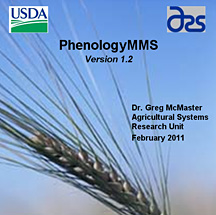This page has been archived and is being provided for reference purposes only. The page is no longer being updated, and therefore, links on the page may be invalid.
| Read the magazine story to find out more. |
|
|
Software Reveals Critical Crop Growth Stages
By Don ComisMay 12, 2011
U.S. Department of Agriculture (USDA) agronomist Greg McMaster has developed computer software that tells farmers when to spray pesticides. McMaster works at the Agricultural Research Service (ARS) Agricultural Systems Research Unit in Fort Collins, Colo. ARS is USDA's principal intramural scientific research agency.
The software, called "PhenologyMMS (Modular Modeling System)," predicts the timing of plant growth stages so Central Great Plains farmers and ranchers can know how their crop is progressing and when to apply pesticides, fertilizers and water. PhenologyMMS also helps them time other management tasks.
Working with Debbie Edmunds, a biological plant science technician at the research unit, McMaster developed this decision support tool after answering numerous calls from farmers and ranchers who wondered when their crop would be at the right stage to spray, as required by the pesticide label.
The pesticide label gives the scientific name of the growth stage, but no other hints. McMaster's program gives common names to go with the scientific names and tells growers how to identify the stage and when to expect each stage, based on weather reports and soil moisture.
All farmers have to do to find the right timing is answer questions such as "What is your planting date?" and "How wet was your soil at planting time?" To answer this question, farmers choose one of these moisture level descriptions: "optimum," "medium," "dry" or "planted in dust." The last step is identifying the nearest weather station to access weather data to run a simplified model of crop growth for each crop chosen. The driving force of the program is cumulative temperature.
The program then simulates crop growth stages for the entire growing season, giving farmers a good idea of when each stage should occur.
The program is unique because it covers many crops, whereas most such programs cover only one crop. This program includes corn, wheat, barley, sorghum, dry beans, sunflowers and several millet varieties, and is continually being expanded.
The program can be used independently or inserted into existing crop growth models.
The program can be downloaded at: /services/software/download.htm?softwareid=238.
This research supports the USDA commitment to sustainable agriculture.


